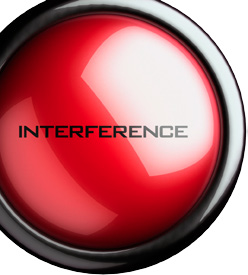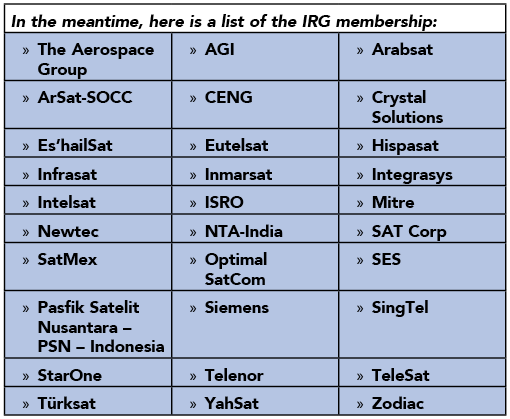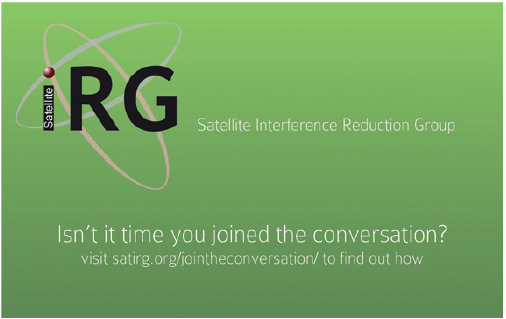As we enter into 2014, there are, yet again, a number of important milestones for us to reach in the fight against satellite interference.

Upcoming are the first of the next round of global sporting events, with the Winter Olympics in Sochi, the World Cup in Rio and the Commonwealth Games in Scotland. With so much occurring, IRG will keep you updated as we move forward—this new column will include views, opinions, and updates from the IRG full members each quarter.
IRG—What’s It All About?
I’m sure many of you are already familiar with the issue of satellite interference and the formation of the Satellite Interference Reduction Group (IRG). For a recap, this organization was formed in 1997 as the Satellite Users Interference Reduction Group, then reformed with a new Executive Director (yours truly), a new board of Directors, and a new name (the word “users” was dropped).
As the name suggests, the organization is all about reducing satellite interference, which is accomplished through improving technology and processes, informed debate and better understanding, which naturally leads to a reduction in satellite interference.
In reality, satellite interference only affects a small number of services. When it does occur, it can be extremely detrimental to those experiencing the interference. The IRG is working closely with the entire industry to reduce it.
On the other side of the coin, the work we are doing means greater efficiency, improvements for operators, manufacturers, and users across the board, whether they are experiencing satellite interference or not.
Why Do We Need IRG?
The role of IRG is four-fold. First, as a forum for open discussion; secondly as a lobbying force; thirdly as a gatherer of information; and finally as an innovator and supporter of new technologies such as Carrier ID.
Discussion Forum
IRG is able to serve as a unique industry forum, offering its members the opportunity to share information and drive change in a coordinated way. There is an annual conference, where experts from every sector of the industry discuss the most important trends, and, more importantly, actions are decided upon—such as, what do we do next?
The IRG also hosts meetings, often in unison with the Global VSAT Forum (GVF) at major tradeshows throughout the year, including Satellite 2014, CommunicAsia, and IBC. This year, we are looking at hosting a second mini-conference, giving our members even more platforms to discuss with one another to gain further understanding of interference issues and thereby solving important issues.
At all of these meetings case studies are presented and they are always popular. These presentations reveal how instances of interference have been solved, often due to the collaboration between operators. Also brought to the forefront are issues that still require resolution. These are invaluable to those who are suffering similar instances of interference, and we encourage open discussions. Attendees can bring current issues to the table and receive assistance and advice.
When we are not running events, IRG members can access this service on an ad hoc basis, emailing us with current challenges they are experiencing. We then push this information to other members to help find a solution. They also have access to our resource library, including presentations, and those all-important case studies.
Lobbying Force
Over recent years, IRG has become recognized as a leading force for change in the industry. IRG is everywhere and we talk to people and get things done. The most significant example of this has to have been the Carrier ID (CID) in time for the 2012 London Olympics campaign.
IRG persuaded operators to make CID effective on video transmissions—the manufacturers came on board to ensure there would be equipment at the ready to handle CID and to test the equipment before the games themselves. IRG assisted with aggressive marketing and lobbying ahead of the Olympics, which ensured that broadcasters wanted CID and interference-free transmissions. The result was an interference-free Olympics with happy broadcasters, happy operators and happy viewers.
In parallel was our campaign to cement a standard into place for the new CID technology. The IRG promoted the new CID technology, which was developed by Comtech and organized a meeting of manufacturers to get that ball rolling. Manufacturers, with special efforts from Newtec and Ericsson and the DVB, led to this improved technology becoming a DVB Specification and an ETSI standard in May of 2013.

Getting The Facts
This leads into another aspect of IRG’s importance—information gathering. Being a neutral organization, the organization is in a unique position as it is able to gather vital information from different, often competing, organizations. This allows us to obtain an accurate snapshot of exactly what is happening, right now, to gain better trending analysis and evaluations which ensure that we focus on corrective remedies.
The chair of our VSAT working group, Thomas van den Driessche of Newtec has, for example, been gathering statistics specifically on VSAT interference. Also, in 2013, we teamed up with Newtec to conduct a survey about CID implementation, which led to some interesting statistics, including the fact that 93 percent of respondents do suffer from some form of interference. You can read more by accessing this infopage: http://www.newtec.eu/article/release/93-of-the-industry-suffers-from-satellite-interference
New Technology
By helping to innovate and support new technologies to improve our industry, including technical ingenuity that helps form new standards, is how IRG can work on better reactive tools to deal with the various forms of interference that affect transmissions around the globe.
We have implemented many achievements throughout the last couple of years. However, all of these initiatives can only be successful if we can encourage widespread implementation of CID. The new CID technology is a fantastic step in the correct direction, but now we need to get users to require it and put the processes in place between the satellite operators to handle the monitoring and operation of CID. We are beginning to see a number of products available that are able to handle CID and you can review the list on the IRG website at this URL: http://satirg.org/resources/cid-ready-products/
At the upcoming Satellite 2014 trade exhibition, we will be hosting a “Carrier ID Tour,” taking attendees around the various stages of CID, from its transmission, monitoring, and detection to the resolution process. Hopefully this will help educate and inform those who wish to better understand the processes involved, the simplicity of CID, as well as highlighting the plethora of products already available with CID. If you are interested in taking part in this tour, please email press@satirg.org
My other goal for 2014 is to improve Geolocation technology and all associated processes. Ultimately, Geolocation is the most valuable offering within our toolkit, enabling operators to locate the source of all types of interference. Of course, for intentional interference, it is often the only method of determining the source. By developing new features for Geolocation, we will improve location of the interference source more efficiently and with better accuracy.
IRG is working with key Geolocation suppliers to standardize the procedures, data gathering and reporting, for all types of geo-located interference. The simpler process will reduce time to action and better records and, where necessary, better evidence. From this we hope to gain improved statistics that will help us understand the problem and be able spot interference patterns for speedier resolution and, perhaps, predict when incidents are likely to occur.
With that in mind, my goal for the next 12 months is for the industry to supply standardized Geolocation reports with the eventual inclusion for ITU submissions and to start the migration process to a formal ISO standard.
Working Together
In 2013, I attended 16 events on five continents and beat the drum for IRG and all of our initiatives for reducing satellite interference. However, IRG is not just Martin Coleman.
IRG offers members a forum and support and we also rely on them to help make the organization relevant and important. Our Board of Directors, who are elected from the full members, often speak on our behalf at industry events, as well as support all of our many-faceted activities.
We also have the Chairs of our three working groups busy making things happen and obtaining positive results. With that in mind, and as mentioned above, the next column will feature opinions, comments, and updates from within our membership and from those around us on the ground—it’s all about getting things done!

The IRG is comprised of four main working groups that cover: Carrier ID (SCPC), Intentional Interference (Technology), VSAT (Statistics), and the End Users Initiative, addressing training, best practices and documentation. Each group is chaired by a key industry expert who is charged with the task of ensuring progress in each of those areas, in establishing the practical initiatives and obtaining the support of the entire industry.
VSAT (Statistics)
Intentional Interference
Carrier ID
End Users Initiative
Some of the latest efforts by IRG is their campaign to achieve Carrier Identification (CID) implementation on all video carriers are as follow:
The Global VSAT Forum (GVF), Satellite Interference Reduction Group (IRG), and the Radio Frequency Interference – End Users Initiative (RFI-EUI) announced last November a launched, joint initiative to implement interference prevention measures more deeply throughout the broadcast sector.
The launch follows a number of important milestones, including a meetings of the Arab States Broadcasting Union (ASBU) in Tunis, where a significant action plan was agreed upon. The action plan is aimed at establishing a public awareness campaign to highlight that intentional interference will not prevent the media message being delivered. The plan includes guidelines around training, Earth station approvals, and Carrier ID (CID), as well as regulatory and political actions.
The World Broadcasting Unions—International Satellite Operations Group (WBU-ISOG)—also issued a number of important resolutions that related to the implementation of Carrier ID. These resolutions support the requirement that by January 1st of 2015, all new model modulators and codecs with integrated modulators purchased by end users for video uplinking should contain a CID. They also stated that all uplinkers of SCPC and MCPC Video and Data should include CID functionality in the required specifications of all current and future Requests for Proposal, with immediate effect. The WBU-ISOG has also just approved and adopted the ASBU Action Plan, following its meeting in Rio de Janeiro.
Then there was the initiative for the Football World Cup in 2014 was first announced during the IRG Annual Conference in Rio de Janeiro last October, where the group’s Executive Director lay down the gauntlet to those present to make this happen. The announcement follows the success of a similar campaign leading up to the London Olympics, where half of the carriers had ID. This resulted in few instances of interference, and the hope is that the industry can take it one step further in time for the Football World Cup in 2014.
“We are entering the challenging part of implementing CID,” commented Martin Coleman, Executive Director, IRG. “We have the ETSI standard, fantastic, but now the hard work begins! Building the system, databases and processes, and ensuring widespread implementation and getting the users to turn CID on!”
The Space Data Association and Analytical Graphics Inc. revealed the first demonstration of the prototype CID database at the IRG conference in Brazil. The creators are now encouraging feedback and input from the industry in order to build the final working database. The other part of this campaign is to educate users about CID and crucially, how to turn it on.

To learn more about IRG: http://www.satirg.org/
About the author
Martin Coleman is Executive Director, the Satellite Interference Reduction Group (IRG). Since taking on the position in 2011, Martin has been active in spearheading a number of significant initiatives, including a campaign to introduce Carrier ID across all SCPC transmissions from the 2012 Olympics through to being ready for full industry implementation by January 1, 2015. Martin regularly addresses the industry on the subject of satellite interference, at global industry events, on an individual basis, and at the IRG annual conference.
Martin is also the Director of his own monitoring and control company, Colem, as well as responsible for European Sales for Crystal Solutions, a leading provider of Network Management Systems plus automation control (NMS+) for the video distribution industry.



